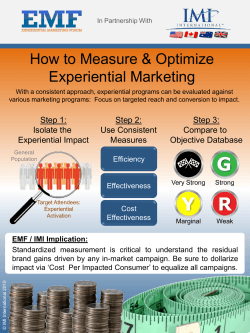
Interactive Technology Design ID 4220 A course on how to design
--- Interactive Technology Design ID 4220 A course on how to design for physical interaction Photos show examples of ITD projects from various design cycles in the course. Interactive Technology Design is a design project within the Master (MSc) Design for Interaction at Delft University of Technology. The project runs only in the spring semester and has a study load of 160 hours (6 ECTS). In this project, students both conceptualise and prototype human-product interaction, i.e. the way people use, understand, and experience products. We focus on physical interactions facilitated by embedded digital technology as opposed to display- or screenbased interactions. The students’ challenge is to develop a great concept and demonstrate that by means of an experiential prototype. Structure and approach • The students start their projects for a concrete design assignment for an accessible context and a specific user group. The highly iterative design process in Interactive Technology Design involves them in a minimum of 5 design cycles with concrete working prototypes as deliverables. • Rough cycle, on the first day of the course they design, construct and demonstrate a first working prototype based on a computer game that they appropriate to their design assignment. • Standalone cycle, in 3 weeks they design, construct and demonstrate a prototype based on their own ideas for the assignment. The prototype should partially function by itself but may have functions that are “fake”, as in enacted by a human operator filling in the gap in functionality. • Nutcracking cycle, in 5 weeks the students design, construct and demonstrate a prototype that involves the hardest technology they need to master to make the concept experiential. • User cycle, at this stage the students are asked to test their nut cracking prototype in context with the targeted users to learn those people understand the concept and understand how to interact with it. • Integration cycle: the last design cycle takes 7 weeks and involves designing, constructing and delivering a prototype that is both functional and refined enough to have users interact with it as if it where a real product. The culmination of this design cycle is a public user test in the style of an exhibition. The public is invited to explore all student projects to provide feedback on the success of the designed concept. Why would you as a company work with the students in this course? Collaboration with companies will provide the students with societally relevant contexts and will show the students which questions companies face with regards to possible future developments. The students will provide the collaborating company with new insights into possible directions for future developments, from the perspective of a new, emerging design generation. To make it possible for the students to start exploring interactions from the start of the course the design assignment should be as concrete as possible and in addition be motivated by earlier research or some concrete desire of the company to explore a specific type of interaction. Photos show examples of ITD projects from various design cycles in the course. What do we expect from your company? 1.One or two contact persons of your company to be present during the following activities: • a kick-off assignment introduction to present the company and the design assignment, motivated by earlier work or examples (1 hour) • the students’ presentations of the standalone and nut cracking design cycles (1 hour per presentation). • the students’ final presentations of the course (4 hours). 2.Your commitment to the entrance fee The entrance fee is based on sponsoring the costs involved with prototyping and facilitation of the technology tools by the faculty. Additional costs are involved with obtaining exclusive rights to the results of the project (details to be discussed). Interested? Please contact Ing. A.J.C. van der Helm Ea.j.c.vanderhelm@tudelft.nl T +31 (0)15 2781966 Uhttp://studiolab.ide.tudelft.nl/itd
© Copyright 2025





















